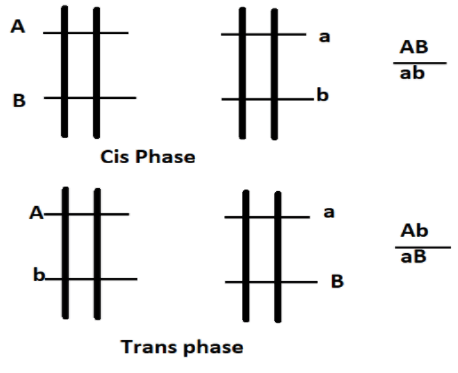
Answer
380.1k+ views
Hint: When genes are present close together on the same chromosome, they are known as linked genes. This means that the alleles that are already together on one chromosome will be inherited as a unit more frequently.
Complete answer:
Sometimes, two traits can be seen together and are inherited together. These genes are present in close proximity to each other. This is known as linkage. For example, in the case of corn, the traits for colour and fullness of the kernel are usually carried on one gene, and the recessive alleles for these traits are carried on another gene.
When both the dominant or recessive alleles for two traits are carried on the same chromosome, it is known as cis arrangement as shown in the figure below.
When recessive and dominant alleles for the different traits are carried on the same chromosome, then it is known as trans arrangement as shown in the figure below.

In case the dominant alleles are partially present on the same chromosomes and partially on different chromosomes, then it is known as partly cis partly trans arrangement. According to the question an individual has heterozygous for two pairs of linked genes (AaBb) possesses the two dominant genes on one homologous chromosome pair and two recessive genes on the other.
Additional Information: Genetic linkage is the tendency of DNA sequences that are close to each other on a chromosome to be inherited together during the meiosis phase of sexual reproduction. Two genetic markers which are close to each other are highly unlikely to be separated into different chromatids during the chromosomal crossover.
Thus the correct answer is option ‘C’.
Note: When the genes are on different chromosomes, or far apart on the same chromosomes, they group differently. This means that when the genes go into gametes, the allele received for one gene does not affect the allele received for the other gene. In the case of double heterozygous organisms (AaBb), this causes the formation of all the four possible types of gametes with equal or 25% frequency.
Complete answer:
Sometimes, two traits can be seen together and are inherited together. These genes are present in close proximity to each other. This is known as linkage. For example, in the case of corn, the traits for colour and fullness of the kernel are usually carried on one gene, and the recessive alleles for these traits are carried on another gene.
When both the dominant or recessive alleles for two traits are carried on the same chromosome, it is known as cis arrangement as shown in the figure below.
When recessive and dominant alleles for the different traits are carried on the same chromosome, then it is known as trans arrangement as shown in the figure below.

In case the dominant alleles are partially present on the same chromosomes and partially on different chromosomes, then it is known as partly cis partly trans arrangement. According to the question an individual has heterozygous for two pairs of linked genes (AaBb) possesses the two dominant genes on one homologous chromosome pair and two recessive genes on the other.
Additional Information: Genetic linkage is the tendency of DNA sequences that are close to each other on a chromosome to be inherited together during the meiosis phase of sexual reproduction. Two genetic markers which are close to each other are highly unlikely to be separated into different chromatids during the chromosomal crossover.
Thus the correct answer is option ‘C’.
Note: When the genes are on different chromosomes, or far apart on the same chromosomes, they group differently. This means that when the genes go into gametes, the allele received for one gene does not affect the allele received for the other gene. In the case of double heterozygous organisms (AaBb), this causes the formation of all the four possible types of gametes with equal or 25% frequency.
Recently Updated Pages
Who among the following was the religious guru of class 7 social science CBSE

what is the correct chronological order of the following class 10 social science CBSE

Which of the following was not the actual cause for class 10 social science CBSE

Which of the following statements is not correct A class 10 social science CBSE

Which of the following leaders was not present in the class 10 social science CBSE

Garampani Sanctuary is located at A Diphu Assam B Gangtok class 10 social science CBSE

Trending doubts
A rainbow has circular shape because A The earth is class 11 physics CBSE

Which are the Top 10 Largest Countries of the World?

How do you graph the function fx 4x class 9 maths CBSE

Fill the blanks with the suitable prepositions 1 The class 9 english CBSE

The Equation xxx + 2 is Satisfied when x is Equal to Class 10 Maths

Find the value of the expression given below sin 30circ class 11 maths CBSE

What is the length of the alimentary canal in human class 11 biology CBSE

Give 10 examples for herbs , shrubs , climbers , creepers

What is BLO What is the full form of BLO class 8 social science CBSE




